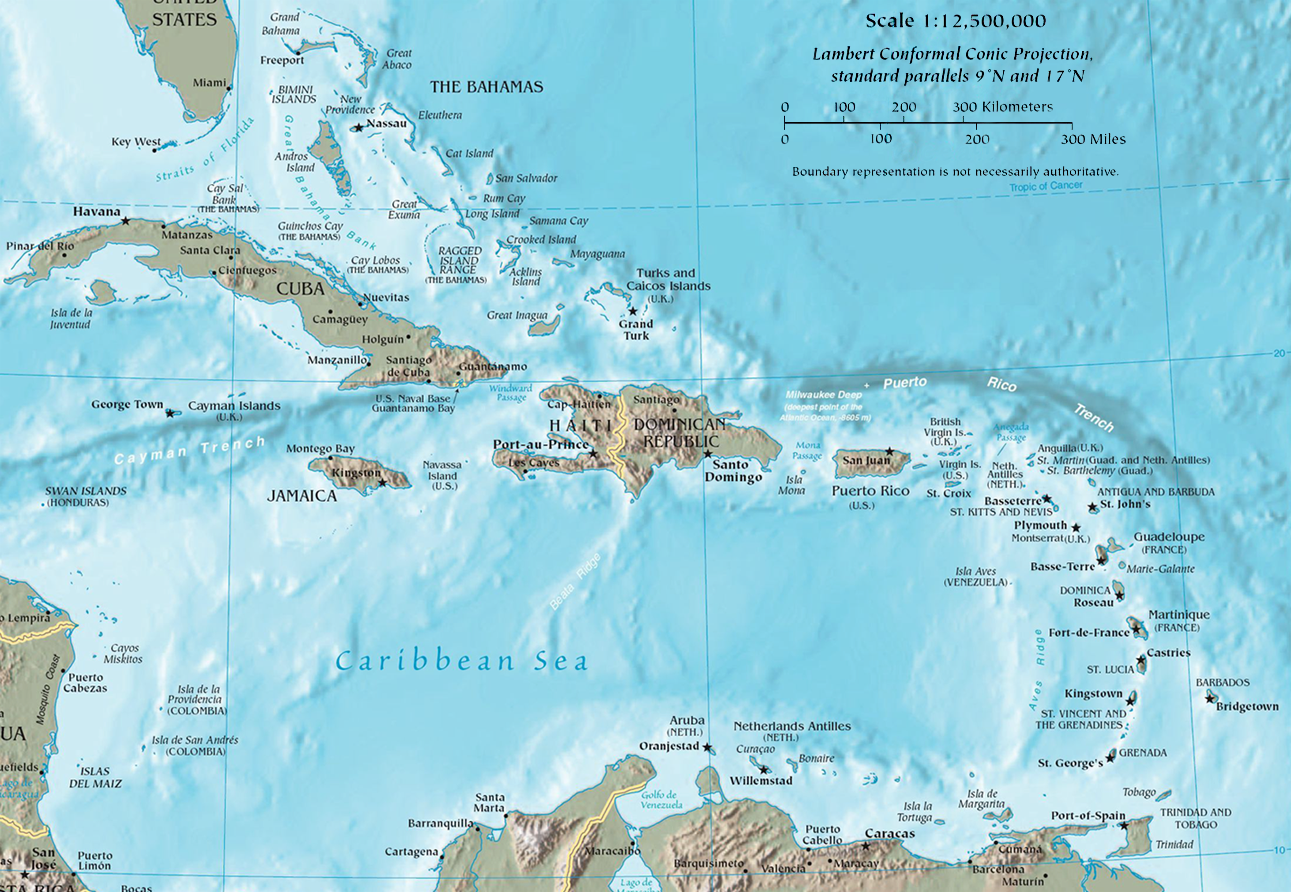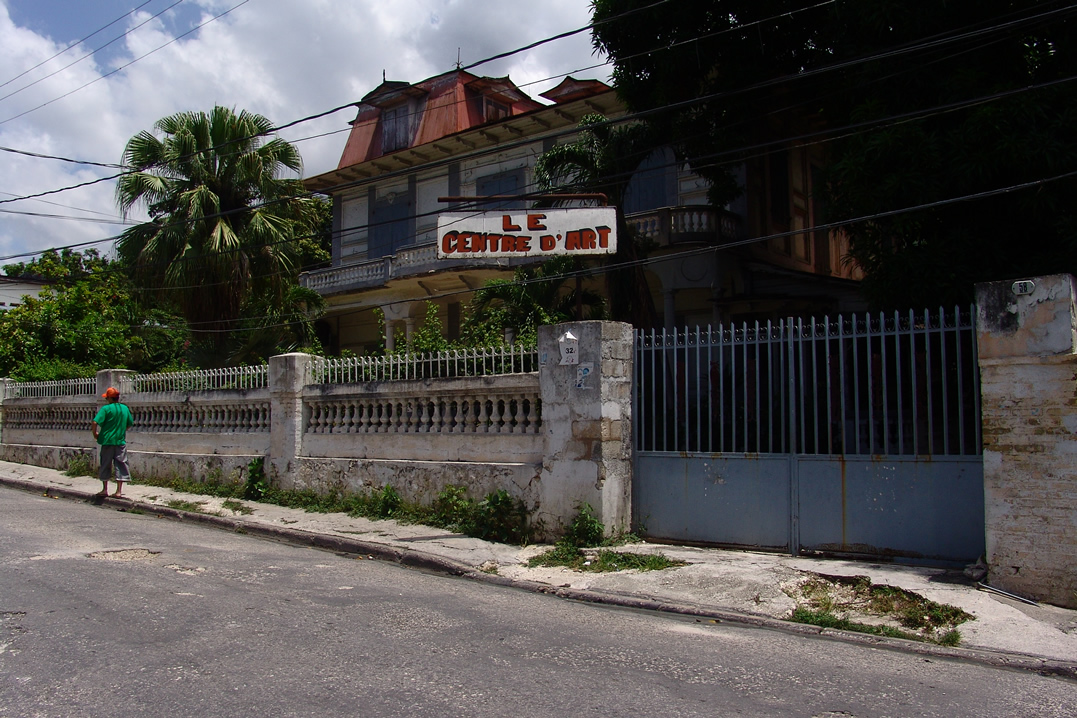|
Holy Trinity Cathedral, Port-au-Prince
The Holy Trinity Cathedral, Port-au-Prince (french: Cathédrale Sainte Trinité) was the main cathedral in the Episcopal Diocese of Haiti. The building was located in downtown Port-au-Prince at the corner of Ave. Mgr. Guilloux & Rue Pavée. Holy Trinity Cathedral has been destroyed six times, including in the devastating earthquake on January 12, 2010. Murals The present Holy Trinity Cathedral was known for its interior murals, which depicted various stories from the Bible using only people of black African heritage. The murals were painted by some of the best-known Haitian painters of the twentieth century, including Philomé Obin, Castera Bazile, Rigaud Benoit, Gabriel Leveque, Adam Leontus, Wilson Bigaud, Jasmin Joseph, and Préfete Dufaut. They were created under the direction of DeWitt Peters and Selden Rodman of the Centre d'Art, and finished between 1950 and 1951. 2010 earthquake Holy Trinity Cathedral was heavily damaged in the 2010 Haiti earthquake, and later ... [...More Info...] [...Related Items...] OR: [Wikipedia] [Google] [Baidu] |
Wilson Bigaud
Wilson Bigaud (29 January 1931 – 22 March 2010) retrieved 2 Dec 2010 was a Haitian painter. Born in Port-au-Prince, Bigaud first worked with clay before becoming a Painting, painter. At the International Exhibit in Washington, D.C., in 1950 Bigaud won second place for a painting entitled "Paradise". He also painted a mural in the Holy Trinity Cathedral, Port-au-Prince, Holy Trinity Cathedral of Port-au-Prince which depicts the Marriage at Cana. He was a member of the artist group founded by Hector Hyppolite. References * * 1931 births Haitian painters Haitian male painters 2010 deaths Naïve painters {{Haiti-painter-stub ...[...More Info...] [...Related Items...] OR: [Wikipedia] [Google] [Baidu] |
Religious Organizations Established In 1863
Religion is usually defined as a social-cultural system of designated behaviors and practices, morals, beliefs, worldviews, texts, sanctified places, prophecies, ethics, or organizations, that generally relates humanity to supernatural, transcendental, and spiritual elements; however, there is no scholarly consensus over what precisely constitutes a religion. Different religions may or may not contain various elements ranging from the divine, sacred things, faith,Tillich, P. (1957) ''Dynamics of faith''. Harper Perennial; (p. 1). a supernatural being or supernatural beings or "some sort of ultimacy and transcendence that will provide norms and power for the rest of life". Religious practices may include rituals, sermons, commemoration or veneration (of deities or saints), sacrifices, festivals, feasts, trances, initiations, funerary services, matrimonial services, meditation, prayer, music, art, dance, public service, or other aspects of human culture. Religions have sa ... [...More Info...] [...Related Items...] OR: [Wikipedia] [Google] [Baidu] |
Buildings And Structures In Port-au-Prince
A building, or edifice, is an enclosed structure with a roof and walls standing more or less permanently in one place, such as a house or factory (although there's also portable buildings). Buildings come in a variety of sizes, shapes, and functions, and have been adapted throughout history for a wide number of factors, from building materials available, to weather conditions, land prices, ground conditions, specific uses, prestige, and aesthetic reasons. To better understand the term ''building'' compare the list of nonbuilding structures. Buildings serve several societal needs – primarily as shelter from weather, security, living space, privacy, to store belongings, and to comfortably live and work. A building as a shelter represents a physical division of the human habitat (a place of comfort and safety) and the ''outside'' (a place that at times may be harsh and harmful). Ever since the first cave paintings, buildings have also become objects or canvasses of much artist ... [...More Info...] [...Related Items...] OR: [Wikipedia] [Google] [Baidu] |
Anglican Cathedrals In The Caribbean
Anglicanism is a Western Christianity, Western Christian tradition that has developed from the practices, liturgy, and identity of the Church of England following the English Reformation, in the context of the Protestant Reformation in Europe. It is one of the largest branches of Christianity, with around 110 million adherents worldwide . Adherents of Anglicanism are called ''Anglicans''; they are also called ''Episcopalians'' in some countries. The majority of Anglicans are members of national or regional Ecclesiastical province#Anglican Communion, ecclesiastical provinces of the international Anglican Communion, which forms the third-largest Christian Communion (Christian), communion in the world, after the Roman Catholic Church and the Eastern Orthodox Church. These provinces are in full communion with the See of Canterbury and thus with the Archbishop of Canterbury, whom the communion refers to as its ''Primus inter pares#Anglican Communion, primus inter pares'' (Latin, ... [...More Info...] [...Related Items...] OR: [Wikipedia] [Google] [Baidu] |
Episcopal Life Online
Episcopal may refer to: *Of or relating to a bishop, an overseer in the Christian church *Episcopate, the see of a bishop – a diocese * Episcopal Church (other), any church with "Episcopal" in its name ** Episcopal Church (United States), an affiliate of Anglicanism based in the United States * Episcopal conference, an official assembly of bishops in a territory of the Roman Catholic Church *Episcopal polity, the church united under the oversight of bishops *Episcopal see, the official seat of a bishop, often applied to the area over which he exercises authority * Historical episcopate, dioceses established according to apostolic succession See also * Episcopal High School (other) * Pontifical (other) The Pontifical is a liturgical book used by a bishop. It may also refer specifically to the Roman Rite Roman Pontifical. When used as an adjective, Pontifical may be used to describe things related to the office of a Bishop (see also Pontiff#Chris . ... [...More Info...] [...Related Items...] OR: [Wikipedia] [Google] [Baidu] |
Primary Schools
A primary school (in Ireland, the United Kingdom, Australia, Trinidad and Tobago, Jamaica, and South Africa), junior school (in Australia), elementary school or grade school (in North America and the Philippines) is a school for primary education of children who are four to eleven years of age. Primary schooling follows pre-school and precedes secondary schooling. The International Standard Classification of Education considers primary education as a single phase where programmes are typically designed to provide fundamental skills in reading, writing, and mathematics and to establish a solid foundation for learning. This is ISCED Level 1: Primary education or first stage of basic education.Annex III in the ISCED 2011 English.pdf Navigate to International Standard Classification of Educati ... [...More Info...] [...Related Items...] OR: [Wikipedia] [Google] [Baidu] |
Trade Schools
A vocational school is a type of educational institution, which, depending on the country, may refer to either secondary or post-secondary education designed to provide vocational education or technical skills required to complete the tasks of a particular and specific job. In the case of secondary education, these schools differ from academic high schools which usually prepare students who aim to pursue tertiary education, rather than enter directly into the workforce. With regard to post-secondary education, vocational schools are traditionally distinguished from four-year colleges by their focus on job-specific training to students who are typically bound for one of the skilled trades, rather than providing academic training for students pursuing careers in a professional discipline. While many schools have largely adhered to this convention, the purely vocational focus of other trade schools began to shift in the 1990s "toward a broader preparation that develops the acade ... [...More Info...] [...Related Items...] OR: [Wikipedia] [Google] [Baidu] |
Caribbean
The Caribbean (, ) ( es, El Caribe; french: la Caraïbe; ht, Karayib; nl, De Caraïben) is a region of the Americas that consists of the Caribbean Sea, its islands (some surrounded by the Caribbean Sea and some bordering both the Caribbean Sea and the North Atlantic Ocean) and the surrounding coasts. The region is southeast of the Gulf of Mexico and the North American mainland, east of Central America, and north of South America. Situated largely on the Caribbean Plate, the region has more than 700 islands, islets, reefs and cays (see the list of Caribbean islands). Island arcs delineate the eastern and northern edges of the Caribbean Sea: The Greater Antilles and the Lucayan Archipelago on the north and the Lesser Antilles and the on the south and east (which includes the Leeward Antilles). They form the West Indies with the nearby Lucayan Archipelago ( the Bahamas and Turks and Caicos Islands), which are considered to be part of the Caribbean despite not borde ... [...More Info...] [...Related Items...] OR: [Wikipedia] [Google] [Baidu] |
Organ (music)
Carol Williams performing at the West_Point_Cadet_Chapel.html" ;"title="United States Military Academy West Point Cadet Chapel">United States Military Academy West Point Cadet Chapel. In music, the organ is a keyboard instrument of one or more Pipe organ, pipe divisions or other means for producing tones, each played from its own Manual (music), manual, with the hands, or pedalboard, with the feet. Overview Overview includes: * Pipe organs, which use air moving through pipes to produce sounds. Since the 16th century, pipe organs have used various materials for pipes, which can vary widely in timbre and volume. Increasingly hybrid organs are appearing in which pipes are augmented with electric additions. Great economies of space and cost are possible especially when the lowest (and largest) of the pipes can be replaced; * Non-piped organs, which include: ** pump organs, also known as reed organs or harmoniums, which like the accordion and mouth organs (both Eastern and ... [...More Info...] [...Related Items...] OR: [Wikipedia] [Google] [Baidu] |
Centre D'Art
Le Centre d’Art, also known as Centre d’Art d'Haïti, is an art center, art school and art gallery located in Port-au-Prince, Haiti. It was founded in 1944 by American watercolorist DeWitt Peters and several prominent Haitians from the intellectual and cultural circles. In 2010, the center's building was destroyed; by 2012 they continued offering classes; and the center's new building is scheduled to reopen by 2021. History The institution was at the center of what became known as the Haitian Art Movement, educating and exhibiting founding artists including Albert Mangones, Gerald Bloncourt, Maurice Borno, Rigaud Benoit, Hector Hyppolite, Daniel Lafontant, Marie-Josée Nadal, Rose-Marie Desruisseaux, and Luce Turnier. Le Centre d’Art was destroyed in the 2010 earthquake and many artworks from its collection was damaged. The Smithsonian Institution as well as several other local and international organisations has since collaborated with recovery and conservation e ... [...More Info...] [...Related Items...] OR: [Wikipedia] [Google] [Baidu] |







